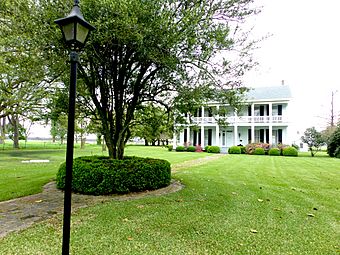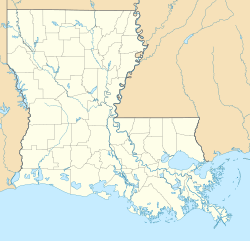Crescent Plantation facts for kids
Quick facts for kids |
|
|
Crescent Plantation
|
|
 |
|
| Location | Along LA 602, about 3 miles (4.8 km) southeast of Tallulah, Louisiana |
|---|---|
| Area | 8.3 acres (3.4 ha) |
| Built | 1832 |
| Architectural style | Greek Revival |
| NRHP reference No. | 84000144 |
| Added to NRHP | October 18, 1984 |
Crescent Plantation is a really old and important house in Madison Parish, near Tallulah, Louisiana. It sits right by Walnut Bayou. The first part of the house was built way back in 1832. Later, in 1855, a main section was added, making it even bigger.
From 1855 until after the Civil War, this plantation was home to a doctor named D.M. Dancy and his wife, Elizabeth DeMoss Dancy. Because of its history, Crescent Plantation was added to the National Register of Historic Places on October 18, 1984. This means it's officially recognized as a special place worth protecting.
Contents
History of Crescent Plantation
Building the Plantation Home
The main house at Crescent Plantation was built on the banks of Walnut Bayou. Workers, who were enslaved people, cut cypress trees from the land. They used a sawmill to prepare the wood for building. This shows how much effort went into creating such a large home.
Later Owners and Changes
Over the years, Crescent Plantation changed hands a few times. Important businessmen, like Gus Wortham from Houston, Texas, and Sterling C. Evans, who was involved with Texas A&M University, owned it for a while. They bought and sold many large properties, including plantations and ranches, in states like Texas, Louisiana, and New Mexico.
Eventually, Sterling C. Evans sold Crescent Plantation to his son-in-law, who was in the grain elevator business in Tallulah. This shows how these large properties were often part of bigger family and business dealings.
What Crescent Plantation Looks Like
Original Design and Features
We don't know who first built the plantation in 1832. But we have a lot of information from 1855 onwards. The front of the house has two stories. It features eight large columns in the Doric style. These columns are simple and strong, giving the house a grand look. There's also a wide balcony on both the first and second floors.
From 1915 until at least 1936, a man named George W. Patterson owned the plantation.
Changes Over Time
By 1936, some changes had been made to the original house. The roof was replaced with one made of galvanized tin. This is a type of metal that resists rust. A restroom was added inside, and a kitchen was built in the back wing of the house. New sheds and barns were also built to hold modern farm equipment. These changes helped the plantation keep up with the times.
Crescent Plantation During the Civil War
Crescent Plantation has an interesting story from the Civil War. It is said that the plantation was saved from being attacked and burned by Union soldiers. This was because Mr. Dancy had a very sick female family member inside the house. Union officers reportedly refused to burn the house down while she was still inside. This act of mercy saved the historic home from destruction.



